Llanelly Tramways
History
Llanelly's 3ft 0ins-gauge horse drawn tramway, which was opened on the 28th September 1882, was owned and operated by the Llanelly Tramways Company. The system was a simple single line and passing loop affair — 0.97 miles long — running northwestwards from the GWR Station along Station Rd, before turning right into Murray St, then left into Cowell St and finally right again into and along Stepney St to the terminus at Woodend.
Information on the company and the tramway is sketchy, but as it lasted for nearly three decades, it must have been at least moderately profitable; in its later years however, it was frequently criticised for being unpunctual and for running dilapidated vehicles on dilapidated track. The only occurrence of note was a court case which the company took out against James Andrews, a local horse omnibus operator and brother of Cardiff entrepreneur Solomon Andrews. James Andrews was using horse buses built to his brother's patent, which were expressly designed to run on tramway rails, thus giving a much smoother ride to the passengers, with less resistance for the horse, and all at no cost to the omnibus proprietor. Despite the company owning the track, and Andrews' buses clearly making use of it, the company lost the case.
In May 1905, the LTCo — along with a moribund company, which had attempted, unsuccessfully, to promote an electric tramway (the Llanelly and District Electric Lighting and Traction Company Limited) — was purchased by the British Power Company Limited. Although this was all done with the express intention of constructing an overhead electric tramway system in and around Llanelly, the Light Railway Order took around two years to obtain (it is unclear why), reconstruction only commencing in early 1908, but seemingly running out of steam (and probably money) shortly afterwards. The last 3ft 0ins-gauge horse tram is thought to have run on the 31st March 1908.
The tramway's fortunes were revived by two employees of J G White and Company Limited (the contractors) — George Balfour and Andrew Beatty — who took up directorships with the LTCo in early 1908, later going on to form Balfour-Beatty and Company in early 1909. Meanwhile, three ex-London County Council horse trams were purchased in order to continue a horse-drawn service on the newly laid track, which had been rebuilt to standard gauge; it is unclear when services recommenced, but probably in April 1908.
BB&Co took control of the LTCo and the L&DEL&TCo in early 1909, and provided the capital to extend the system and equip it for overhead electric working, though it was to be another two years before the first electric services ran, on the 12th June 1911, the last horse trams having run the day before.
It is tempting to speculate whether this long gestation period was in some way due to BB&Co's expansion and acquisition of other provincial tramways and electricity undertakings, the company taking control of four other tramways in 1909 alone (Dartford Council Light Railways; Dunfermline and District Tramways; Llandudno and Colwyn Bay Electric Railway; and Luton Corporation Tramways). These were subsequently followed by the City of Carlisle Electric Tramways (1911); Leamington and Warwick Electric Tramways and Mansfield and District Light Railway; Nottinghamshire and Derbyshire Tramways (1912); Cheltenham and District Light Railway (1914); Falkirk and District Tramways (1920); and lastly, Wemyss and District Tramways (in 1922).
Once again, details of the tramway's finances are very sketchy, though if other BB&Co concerns are anything to go by, it was probably run on a shoe string. The Great War would certainly have had a major impact, with loss of staff, drastically reduced maintenance and severe restrictions on renewals (track and tramcars); in fact, the L&DEL&TCo (the operating company) had to borrow two trams from the Mansfield and District Light Railway during the conflict, though whether they were actually put into service or not is open to question.
Although two new tramcars were obtained after the war, by 1924 the writing was on the wall, BB&Co changing the concern's name to the Llanelly & District Electric Supply Company Limited, which better reflected its core interests. It then sought powers to abandon the tramway and operate trolley buses (a form of traction much favoured by BB&Co at this time, especially where they also owned the electricity generation facilities).
The first route to be converted was the Bynea line, trams presumably being withdrawn on Christmas Eve 1932, the trolley buses taking over two days later on Boxing Day. The last trams were withdrawn less than two months later on the 13th February 1933, to be replaced by trolley buses.
At its maximum extent, Llanelly's electric tramway totalled 6.23 miles, comprising lines from the town centre running: southwards to the GWR Station; westwards to Pwll; northwards to Felin Foel; and eastwards to Bynea. The system was never connected to another tramway, the nearest being in Swansea, separated by some 10 miles and the River Loughor.
Uniforms
Photographs of Llanelly Tramways Company horse trams, which ran from 1882 to 1911, are rare, but those that have survived (see below) suggest that neither uniforms nor licences were worn; tramcar staff therefore wore informal but reasonably smart attire (i.e., jacket with shirt and tie). In later years, headgear certainly took the form of the flat cap, though in earlier years it would doubtless have been the ubiquitous bowler hat.
The photographic record at and following electrification in 1911 is scarcely better, so details of uniforms and insignia are at best, sketchy. Motormen and conductors certainly wore uniforms, and these appear to have been single-breasted with lapels for conductors, and double-breasted 'lancer-style' tunics for motormen; both had upright collars that appear to have borne an employee number on the bearer's left-hand side, and system initials — 'L T C' — on the right-hand side. Caps were military in style with a tensioned crown (top) and appear to have borne a small badge of some description in the early years, possibly an employee number, though this seems to have been relatively quickly superseded by standard, 'off-the-shelf', script-lettering grade badges (either Motorman or Conductor); whether the LTCo used nickel or brass insignia remains unknown. Fortunately, a single good quality studio portrait has survived from 1913 (see below), and this clearly shows that the buttons were plain with a rim (see link).
Tramcar crews were also issued with long, double-breasted greatcoats with five pairs of buttons and high, fold-over collars; these garments do not appear to have carried any insignia.
Although photographs of inspectors, either from the horse or electric eras are unknown, an excellent studio portrait has survived of the Chief Inspector (there was presumably only one given the small size of the system). The latter wore a single-breasted jacket with hidden buttons (or more likely a hook and eye affair) with four slit pockets and upright collars; the pockets, collars and the front of the jacket were all edged with material of a finer quality than the main body. The collars bore the grade — Chief Inspector — in embroidered script lettering. The cap was military in style with a tensioned crown and a glossy peak with black braid; the bearer's grade was carried on an elaborate hat band in embroidered script lettering. It is likely that inspectors wore very similar garb, though confirmation awaits photographic evidence.
It seems likely that female staff were employed during the Great War to replace men lost to the armed services, however, neither photographic nor documentary evidence is currently available which would confirm this (either way).
Further reading
For a very short history of Llanelli's tramways, see: 'The Directory of British Tramways' by Keith Turner; Patrick Stephens Limited (1996).
Images
Horse tram drivers and conductors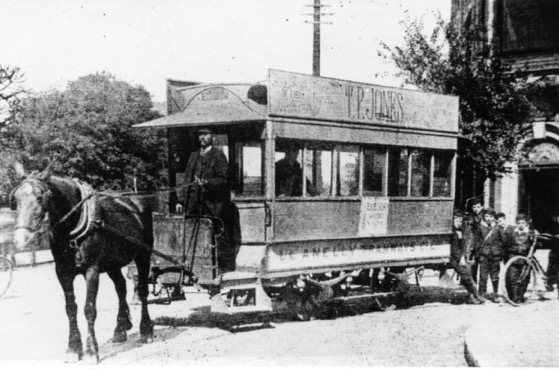
A Llanelly Tramways Company 3ft-gauge horse tram — photo undated, but possibly taken in the 1890s. Photo courtesy of the Tramways and Light Railway Society, with thanks to David Voice.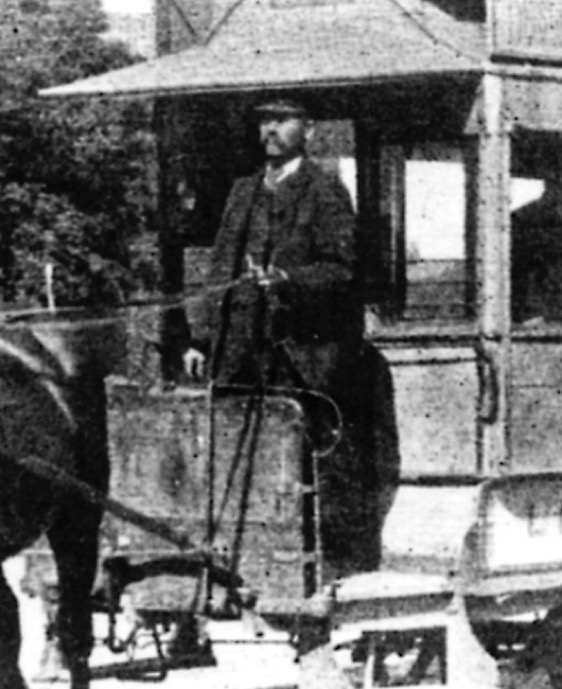
A blow-up of the above photo showing the driver. It is unclear whether or not he is wearing a uniform.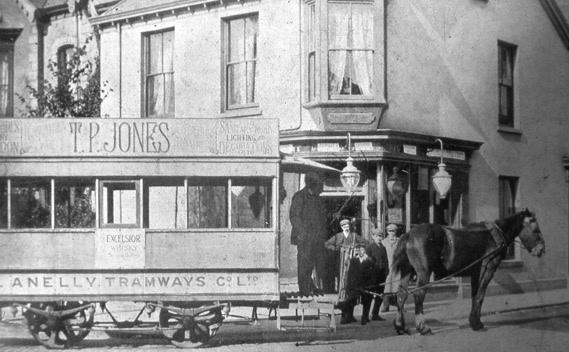
Another shot of what is in all probability the same horse tram as in the previous photo — again undated, but possibly taken in the 1890s. Photo courtesy of the Tramways and Light Railway Society, with thanks to David Voice.
A blow-up of the above photo showing the driver — once again, it is unclear whether he is wearing a uniform or informal attire.
Another four-wheel horsecar, this time captured outside the Melbourne and Oddfellows Inns in Station Rd — photo undated, but probably taken around the turn of the century. Neither of the two men on the tramcar (on the platform and leaning against it) are wearing uniforms. Photo by kind permission of Pwllmag.co.uk. This image is copyright of its rightful owner.
The crew of Horsecar No 1 pose with their charge in the middle of what is thought to be Swansea Rd, patiently waiting for the cameraman to get his shot. Although this photograph has appeared in several publications as 'Neath and District Tramways No 1', the evidence strongly supports an attribution to Llanelly. Firstly, the advert attached to the upper deck decency panel is for a business, and an address, that is known to be valid for Llanelly, and is identical to that seen in another shot of a Llanelly horse tram (see below); secondly, the rail on the left is exposed, with the setts still to be finished (unlike the opposite side), strongly suggesting that the track has been widened, as it was in 1908 in Llanelly (from 3 ft to 4ft 8½ins); and lastly, the car itself is double-deck and standard gauge, and Llanelly is known to have purchased three such trams in 1908, ex-London County Council Tramways. Taken together, this strongly suggests that the photo was taken in Llanelly between 1908 and 1911. I am indebted to David Beynon for the excellent detective work. Photo courtesy of the Tramways and Light Railway Society, with thanks to David Voice.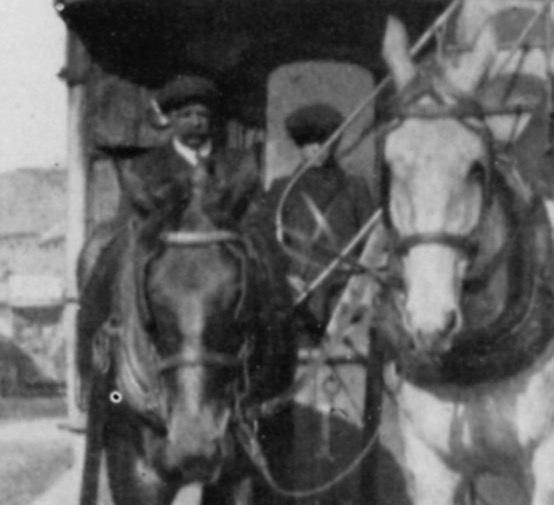
A blow-up of the above photo showing the driver and his very youthful-looking conductor, both of whom are wearing completely informal attire, topped off with flat caps.
A new electric tram, probably undergoing test running, and an ex-London County Council horsecar stand at the junction of Stepney Street and Church Street, almost certainly in June 1911. The David Evans advertisement is identical to that carried on the tram shown above. Both men appear to be wearing informal attire. Original believed to be held by Llanelli Reference Library.
Motormen and conductors
Llanelly and District Electric Lighting and Traction Company Tramcar No 3 outside the Melbourne Inn — photo undated, but probably taken between the inauguration of electric services (on the 12th June 1911) and the start of the Great War. Author's Collection.
A blow-up of the above photo showing the crew. Neither man is wearing a script-lettering grade badge, though the conductor does appear to be wearing a small, round cap badge of some description, though this could equally be an employee number.
A studio portrait of Motorman Fred Luttrell taken in June 1913. Although he has no employee number on his left-hand collar, his right clearly bears 'L T C' system initials. The photo is also sharp enough to discern the pattern of button, plain with a rim. Photo courtesy of the late Brian Cripps; whereabouts of the original unknown.
Script-lettering grade badges of the pattern worn by Llanelly and District Tramways staff. It is currently unclear whether these badges were issued in brass or nickel. Author's Collection.
A poor quality photograph, but the only one I've been able to source from later on in the tramway's life, showing Tramcar No 2 — photo undated, but probably taken in the 1920s. Both men are wearing script-lettering grade badges on their caps. Photo courtesy of the Tramways and Light Railway Society, with thanks to David Voice.
Senior staff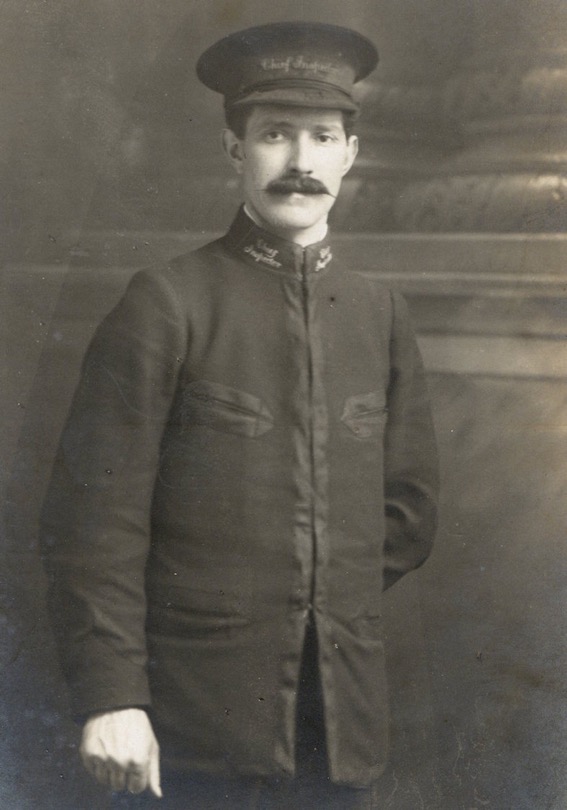
A Llanelly Tramways Chief Inspector — photo undated, but almost certainly taken in the three years prior to the Great War. The photographer was F J Anthony of Llanelly. Author's Collection.
A blow-up of the above photo showing details of the collar and cap insignia.